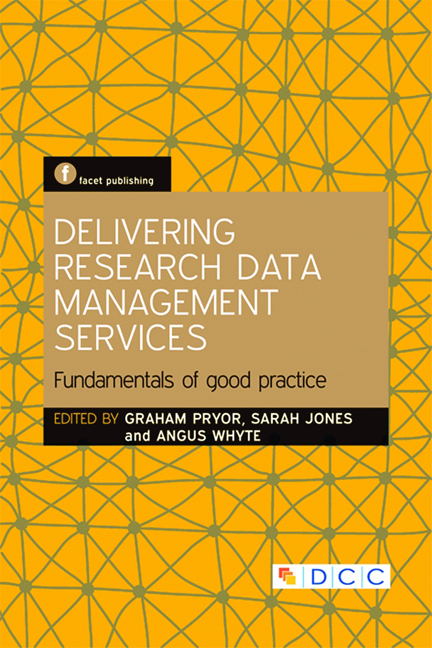Book contents
- Frontmatter
- Contents
- Preface
- Contributors
- 1 A patchwork of change
- 2 Options and approaches to RDM service provision
- 3 Who's doing data? A spectrum of roles, responsibilities and competences
- 4 A pathway to sustainable research data services: from scoping to sustainability
- 5 The range and components of RDM infrastructure and services
- 6 Case study 1: Johns Hopkins University Data Management Services
- 7 Case study 2: University of Southampton – a partnership approach to research data management
- 8 Case study 3: Monash University, a strategic approach
- 9 Case study 4: a national solution – the UK Data Service
- 10 Case study 5: development of institutional RDM services by projects in the Jisc Managing Research Data programmes
- Index
8 - Case study 3: Monash University, a strategic approach
Published online by Cambridge University Press: 08 June 2018
- Frontmatter
- Contents
- Preface
- Contributors
- 1 A patchwork of change
- 2 Options and approaches to RDM service provision
- 3 Who's doing data? A spectrum of roles, responsibilities and competences
- 4 A pathway to sustainable research data services: from scoping to sustainability
- 5 The range and components of RDM infrastructure and services
- 6 Case study 1: Johns Hopkins University Data Management Services
- 7 Case study 2: University of Southampton – a partnership approach to research data management
- 8 Case study 3: Monash University, a strategic approach
- 9 Case study 4: a national solution – the UK Data Service
- 10 Case study 5: development of institutional RDM services by projects in the Jisc Managing Research Data programmes
- Index
Summary
Introduction
Monash University recognizes that if research data is better managed, more discoverable, available for reuse and exposed to relevant communities it will contribute to increased research impact, enhanced research practice (including collaboration) and improved education outcomes.
Monash has taken on the challenge of developing research data management (RDM) using a multifaceted, multilevel and strategic approach. This has included leadership and participation in large Australian Federal Government initiatives at the same time as using ‘little steps’ approaches within the institution. Monash has led national projects to prototype and develop RDM infrastructure, assumed responsibility as the lead agency of the governmentfunded Australian National Data Service (ANDS), formed an institutional structure for RDM governance, established a Strategy and Strategic Plan for 2012–15 and an RDM policy with associated procedures and guidelines, delivered programmes for RDM skills development, established a petabyte data store and developed and deployed a range of disciplinespecific and versatile solutions for the management of research data and associated metadata.
The university continues to identify RDM as critically significant to its research performance and to the fulfilment of compliance requirements and community expectations. All members of the Monash community share responsibility to improve RDM in a coordinated and integrated way; to support this, the university has made ongoing appointments into research data management roles while also seconding librarians and information technology staff into shorterterm positions to build capability and expertise.
This chapter explores the university's work in the period from 2006 to 2013 and examines the issues and challenges to be resolved when planning and implementing effective RDM. It describes in some detail the characteristics of Monash's organizational approach to RDM, explores both the nontechnical and technical components of Monash's RDM infrastructure, looks at what developments are anticipated and outlines Monash's strategy to promote sustainable RDM infrastructure.
Background
Monash University's research environment and history in research data management
Monash University was established in 1958 and comprises ten faculties on six Australian campuses. It also has campuses in Malaysia and South Africa as well as centres in Italy, India and China. The student body numbers around 63,000, from more than 100 countries (7.1% of these are higher degree by research students). The university has approximately 3800 academic staff and received over $AU282 million in externally funded research income in 2011.
- Type
- Chapter
- Information
- Delivering Research Data Management ServicesFundamentals of Good Practice, pp. 163 - 190Publisher: FacetPrint publication year: 2013
- 4
- Cited by



